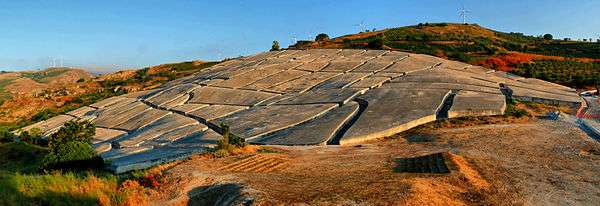Cretto di Burri
The Cretto di Burri (crack of Burri) or Cretto di Gibellina (crack of Gibellina), also known as "The Great Cretto", is a landscape artwork undertaken by Alberto Burri in 1984 and left unfinished in 1989 (due to lack of funds),[1][2] based on the old city of Gibellina. The original city of Gibellina was completely destroyed in the 1968 Belice earthquake.[3] Gibellina has since been rebuilt, about 20 km from the city's original location. In 2015, to mark what would have been Burri's one hundredth birthday, the work was finally completed.[4]
| Il Grande Cretto | |
|---|---|
 | |
| Artist | Alberto Burri |
| Year | 1984–2015 |
| Type | Cement sculpture |
| Dimensions | 150 cm × 35000 cm × 28000 cm (59 in × 14,000 in × 11,000 in) |
| Location | Gibellina, Sicily |
The work is the subject of a short documentary by the Dutch filmmaker Petra Noordkamp which was commissioned by the Solomon R. Guggenheim Museum to be screened at the Alberto Burri retrospective held at the institution from October 9, 2015 until January 6, 2016.[5]
The Cretto is also the subject of the theatrical show "I-TIGI a Gibellina" and its video transposition "I-TIGI Canto per Ustica" by the Italian stage actor, theater director, dramaturge and author Marco Paolini. Entirely shot inside the Cretto di Burri in the year 2000, it's the story of the DC9 ITAVIA that sank in the waters of Ustica in June 1980, and the reconstruction of the long investigation conducted by the italian judge Rosario Priore. The author declared that he choose the Cretto because "it is a sort of concrete labyrinth, which, seen from above, is similar to the maze of lies in which the judges had to orient themselves to find the thread of the investigation".[6]
References
- "Archived copy". Archived from the original on 2014-10-31. Retrieved 2015-08-24.CS1 maint: archived copy as title (link)
- http://www.gibellina.siciliana.it/pages/cretto.html
- "Archived copy". Archived from the original on 2015-04-19. Retrieved 2015-08-24.CS1 maint: archived copy as title (link)
- http://www.abitare.it/en/habitat-en/landascape-design-en/2015/11/06/in-gibellina-the-cretto-by-burri-is-finished-after-30-years/?refresh_ce-cp
- http://5dutchdaysnyc.org/petra-noordkamp-film-on-il-grande-cretto-di-gibellina/%5B%5D
- https://www.jolefilm.com/film/i-tigi-a-gibellina/